Deqian Kong
Reasoning Curriculum: Bootstrapping Broad LLM Reasoning from Math
Oct 30, 2025Abstract:Reinforcement learning (RL) can elicit strong reasoning in large language models (LLMs), yet most open efforts focus on math and code. We propose Reasoning Curriculum, a simple two-stage curriculum that first elicits reasoning skills in pretraining-aligned domains such as math, then adapts and refines these skills across other domains via joint RL. Stage 1 performs a brief cold start and then math-only RL with verifiable rewards to develop reasoning skills. Stage 2 runs joint RL on mixed-domain data to transfer and consolidate these skills. The curriculum is minimal and backbone-agnostic, requiring no specialized reward models beyond standard verifiability checks. Evaluated on Qwen3-4B and Llama-3.1-8B over a multi-domain suite, reasoning curriculum yields consistent gains. Ablations and a cognitive-skill analysis indicate that both stages are necessary and that math-first elicitation increases cognitive behaviors important for solving complex problems. Reasoning Curriculum provides a compact, easy-to-adopt recipe for general reasoning.
Place Cells as Position Embeddings of Multi-Time Random Walk Transition Kernels for Path Planning
May 20, 2025Abstract:The hippocampus orchestrates spatial navigation through collective place cell encodings that form cognitive maps. We reconceptualize the population of place cells as position embeddings approximating multi-scale symmetric random walk transition kernels: the inner product $\langle h(x, t), h(y, t) \rangle = q(y|x, t)$ represents normalized transition probabilities, where $h(x, t)$ is the embedding at location $ x $, and $q(y|x, t)$ is the normalized symmetric transition probability over time $t$. The time parameter $\sqrt{t}$ defines a spatial scale hierarchy, mirroring the hippocampal dorsoventral axis. $q(y|x, t)$ defines spatial adjacency between $x$ and $y$ at scale or resolution $\sqrt{t}$, and the pairwise adjacency relationships $(q(y|x, t), \forall x, y)$ are reduced into individual embeddings $(h(x, t), \forall x)$ that collectively form a map of the environment at sale $\sqrt{t}$. Our framework employs gradient ascent on $q(y|x, t) = \langle h(x, t), h(y, t)\rangle$ with adaptive scale selection, choosing the time scale with maximal gradient at each step for trap-free, smooth trajectories. Efficient matrix squaring $P_{2t} = P_t^2$ builds global representations from local transitions $P_1$ without memorizing past trajectories, enabling hippocampal preplay-like path planning. This produces robust navigation through complex environments, aligning with hippocampal navigation. Experimental results show that our model captures place cell properties -- field size distribution, adaptability, and remapping -- while achieving computational efficiency. By modeling collective transition probabilities rather than individual place fields, we offer a biologically plausible, scalable framework for spatial navigation.
Latent Adaptive Planner for Dynamic Manipulation
May 06, 2025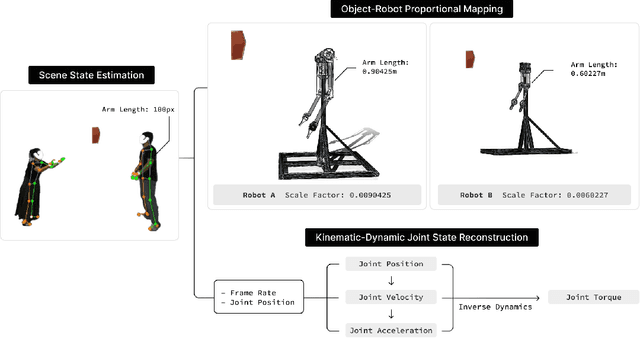



Abstract:This paper presents Latent Adaptive Planner (LAP), a novel approach for dynamic nonprehensile manipulation tasks that formulates planning as latent space inference, effectively learned from human demonstration videos. Our method addresses key challenges in visuomotor policy learning through a principled variational replanning framework that maintains temporal consistency while efficiently adapting to environmental changes. LAP employs Bayesian updating in latent space to incrementally refine plans as new observations become available, striking an optimal balance between computational efficiency and real-time adaptability. We bridge the embodiment gap between humans and robots through model-based proportional mapping that regenerates accurate kinematic-dynamic joint states and object positions from human demonstrations. Experimental evaluations across multiple complex manipulation benchmarks demonstrate that LAP achieves state-of-the-art performance, outperforming existing approaches in success rate, trajectory smoothness, and energy efficiency, particularly in dynamic adaptation scenarios. Our approach enables robots to perform complex interactions with human-like adaptability while providing an expandable framework applicable to diverse robotic platforms using the same human demonstration videos.
Scalable Language Models with Posterior Inference of Latent Thought Vectors
Feb 03, 2025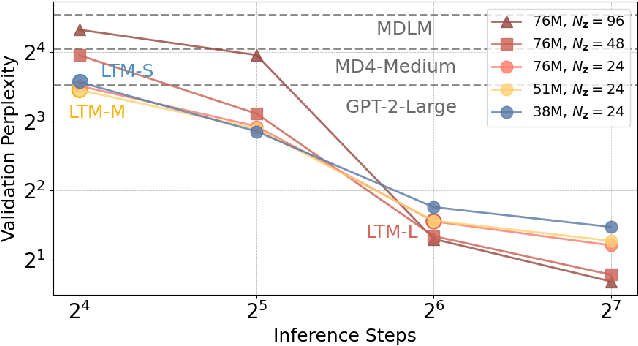

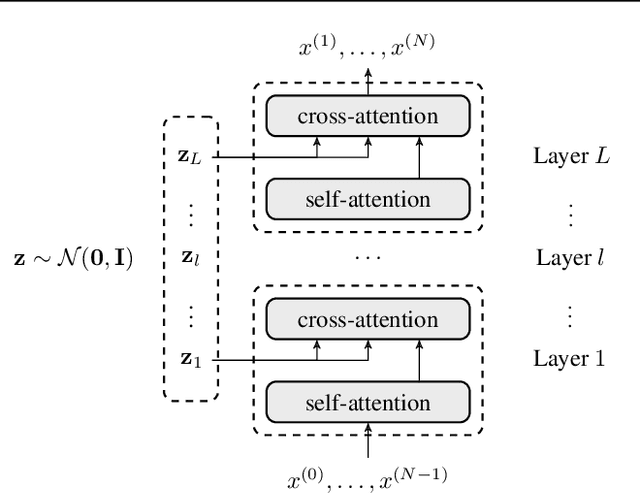
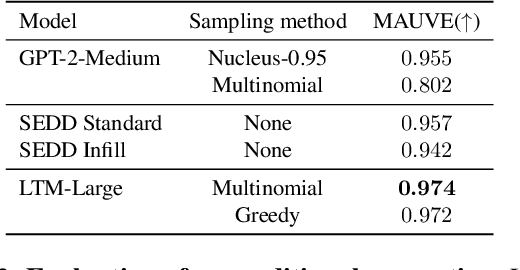
Abstract:We propose a novel family of language models, Latent-Thought Language Models (LTMs), which incorporate explicit latent thought vectors that follow an explicit prior model in latent space. These latent thought vectors guide the autoregressive generation of ground tokens through a Transformer decoder. Training employs a dual-rate optimization process within the classical variational Bayes framework: fast learning of local variational parameters for the posterior distribution of latent vectors, and slow learning of global decoder parameters. Empirical studies reveal that LTMs possess additional scaling dimensions beyond traditional LLMs, yielding a structured design space. Higher sample efficiency can be achieved by increasing training compute per token, with further gains possible by trading model size for more inference steps. Designed based on these scaling properties, LTMs demonstrate superior sample and parameter efficiency compared to conventional autoregressive models and discrete diffusion models. They significantly outperform these counterparts in validation perplexity and zero-shot language modeling. Additionally, LTMs exhibit emergent few-shot in-context reasoning capabilities that scale with model and latent size, and achieve competitive performance in conditional and unconditional text generation.
A minimalistic representation model for head direction system
Nov 15, 2024



Abstract:We present a minimalistic representation model for the head direction (HD) system, aiming to learn a high-dimensional representation of head direction that captures essential properties of HD cells. Our model is a representation of rotation group $U(1)$, and we study both the fully connected version and convolutional version. We demonstrate the emergence of Gaussian-like tuning profiles and a 2D circle geometry in both versions of the model. We also demonstrate that the learned model is capable of accurate path integration.
DODT: Enhanced Online Decision Transformer Learning through Dreamer's Actor-Critic Trajectory Forecasting
Oct 15, 2024

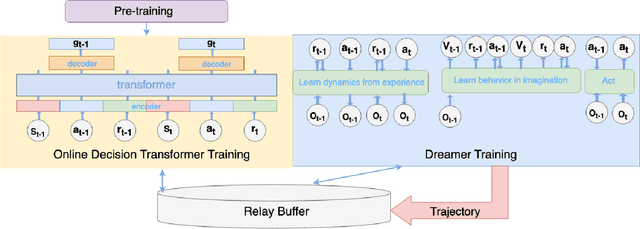
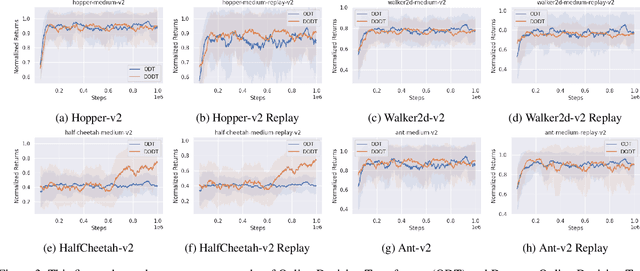
Abstract:Advancements in reinforcement learning have led to the development of sophisticated models capable of learning complex decision-making tasks. However, efficiently integrating world models with decision transformers remains a challenge. In this paper, we introduce a novel approach that combines the Dreamer algorithm's ability to generate anticipatory trajectories with the adaptive learning strengths of the Online Decision Transformer. Our methodology enables parallel training where Dreamer-produced trajectories enhance the contextual decision-making of the transformer, creating a bidirectional enhancement loop. We empirically demonstrate the efficacy of our approach on a suite of challenging benchmarks, achieving notable improvements in sample efficiency and reward maximization over existing methods. Our results indicate that the proposed integrated framework not only accelerates learning but also showcases robustness in diverse and dynamic scenarios, marking a significant step forward in model-based reinforcement learning.
Latent Space Energy-based Neural ODEs
Sep 05, 2024


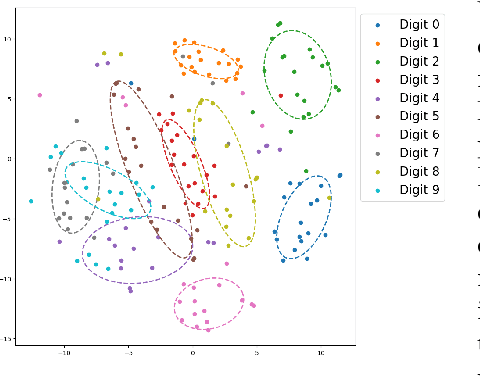
Abstract:This paper introduces a novel family of deep dynamical models designed to represent continuous-time sequence data. This family of models generates each data point in the time series by a neural emission model, which is a non-linear transformation of a latent state vector. The trajectory of the latent states is implicitly described by a neural ordinary differential equation (ODE), with the initial state following an informative prior distribution parameterized by an energy-based model. Furthermore, we can extend this model to disentangle dynamic states from underlying static factors of variation, represented as time-invariant variables in the latent space. We train the model using maximum likelihood estimation with Markov chain Monte Carlo (MCMC) in an end-to-end manner, without requiring additional assisting components such as an inference network. Our experiments on oscillating systems, videos and real-world state sequences (MuJoCo) illustrate that ODEs with the learnable energy-based prior outperform existing counterparts, and can generalize to new dynamic parameterization, enabling long-horizon predictions.
Latent Energy-Based Odyssey: Black-Box Optimization via Expanded Exploration in the Energy-Based Latent Space
May 27, 2024Abstract:Offline Black-Box Optimization (BBO) aims at optimizing a black-box function using the knowledge from a pre-collected offline dataset of function values and corresponding input designs. However, the high-dimensional and highly-multimodal input design space of black-box function pose inherent challenges for most existing methods that model and operate directly upon input designs. These issues include but are not limited to high sample complexity, which relates to inaccurate approximation of black-box function; and insufficient coverage and exploration of input design modes, which leads to suboptimal proposal of new input designs. In this work, we consider finding a latent space that serves as a compressed yet accurate representation of the design-value joint space, enabling effective latent exploration of high-value input design modes. To this end, we formulate an learnable energy-based latent space, and propose Noise-intensified Telescoping density-Ratio Estimation (NTRE) scheme for variational learning of an accurate latent space model without costly Markov Chain Monte Carlo. The optimization process is then exploration of high-value designs guided by the learned energy-based model in the latent space, formulated as gradient-based sampling from a latent-variable-parameterized inverse model. We show that our particular parameterization encourages expanded exploration around high-value design modes, motivated by inversion thinking of a fundamental result of conditional covariance matrix typically used for variance reduction. We observe that our method, backed by an accurately learned informative latent space and an expanding-exploration model design, yields significant improvements over strong previous methods on both synthetic and real world datasets such as the design-bench suite.
Dual-Space Optimization: Improved Molecule Sequence Design by Latent Prompt Transformer
Feb 27, 2024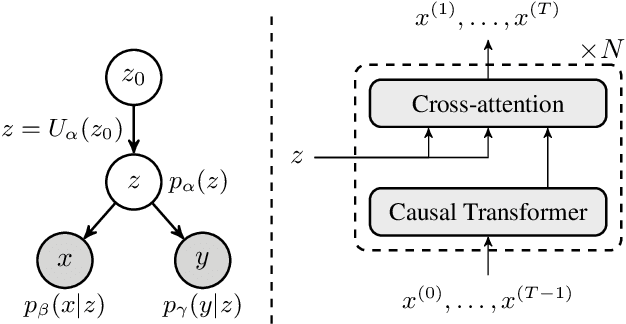
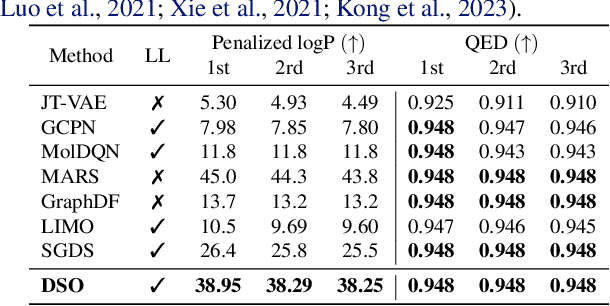
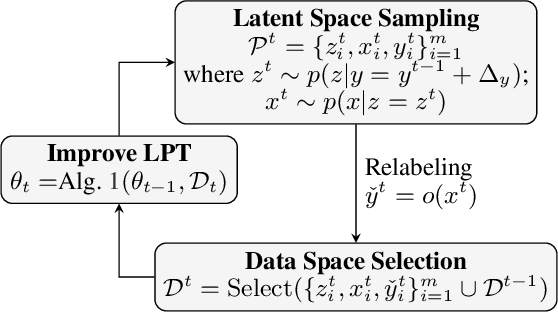
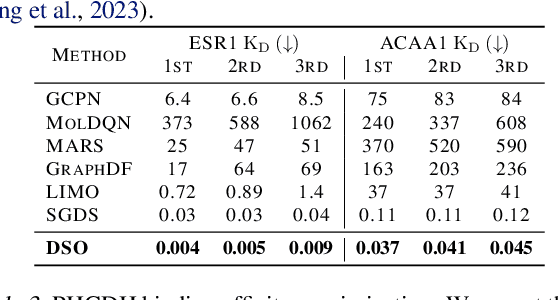
Abstract:Designing molecules with desirable properties, such as drug-likeliness and high binding affinities towards protein targets, is a challenging problem. In this paper, we propose the Dual-Space Optimization (DSO) method that integrates latent space sampling and data space selection to solve this problem. DSO iteratively updates a latent space generative model and a synthetic dataset in an optimization process that gradually shifts the generative model and the synthetic data towards regions of desired property values. Our generative model takes the form of a Latent Prompt Transformer (LPT) where the latent vector serves as the prompt of a causal transformer. Our extensive experiments demonstrate effectiveness of the proposed method, which sets new performance benchmarks across single-objective, multi-objective and constrained molecule design tasks.
Latent Plan Transformer: Planning as Latent Variable Inference
Feb 07, 2024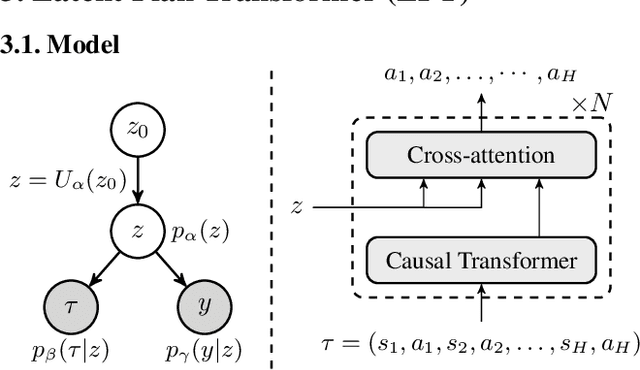


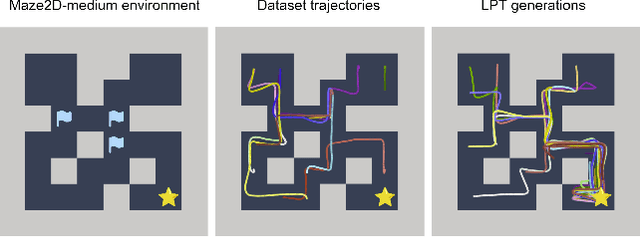
Abstract:In tasks aiming for long-term returns, planning becomes necessary. We study generative modeling for planning with datasets repurposed from offline reinforcement learning. Specifically, we identify temporal consistency in the absence of step-wise rewards as one key technical challenge. We introduce the Latent Plan Transformer (LPT), a novel model that leverages a latent space to connect a Transformer-based trajectory generator and the final return. LPT can be learned with maximum likelihood estimation on trajectory-return pairs. In learning, posterior sampling of the latent variable naturally gathers sub-trajectories to form a consistent abstraction despite the finite context. During test time, the latent variable is inferred from an expected return before policy execution, realizing the idea of planning as inference. It then guides the autoregressive policy throughout the episode, functioning as a plan. Our experiments demonstrate that LPT can discover improved decisions from suboptimal trajectories. It achieves competitive performance across several benchmarks, including Gym-Mujoco, Maze2D, and Connect Four, exhibiting capabilities of nuanced credit assignments, trajectory stitching, and adaptation to environmental contingencies. These results validate that latent variable inference can be a strong alternative to step-wise reward prompting.
 Add to Chrome
Add to Chrome Add to Firefox
Add to Firefox Add to Edge
Add to Edge